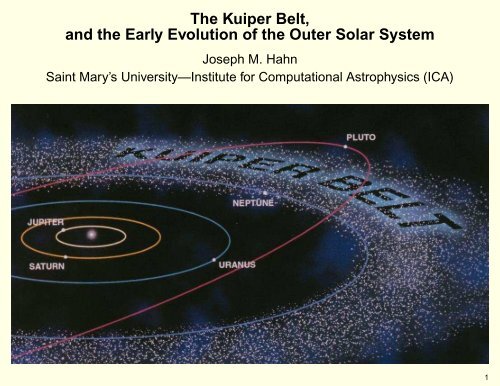The Kuiper Belt, and the Early Evolution of the Outer Solar System
The Kuiper Belt, and the Early Evolution of the Outer Solar System
The Kuiper Belt, and the Early Evolution of the Outer Solar System
You also want an ePaper? Increase the reach of your titles
YUMPU automatically turns print PDFs into web optimized ePapers that Google loves.
<strong>The</strong> <strong>Kuiper</strong> <strong>Belt</strong>,<br />
<strong>and</strong> <strong>the</strong> <strong>Early</strong> <strong>Evolution</strong> <strong>of</strong> <strong>the</strong> <strong>Outer</strong> <strong>Solar</strong> <strong>System</strong><br />
Joseph M. Hahn<br />
Saint Mary’s University—Institute for Computational Astrophysics (ICA)<br />
1
What is <strong>the</strong> <strong>Kuiper</strong> <strong>Belt</strong><br />
• a vast swarm <strong>of</strong> giant comets orbiting just beyond Neptune<br />
– debris that failed to coalesce into ano<strong>the</strong>r planet<br />
• nomenclature isn’t settled:<br />
<strong>Kuiper</strong> <strong>Belt</strong>, Edgeworth–<strong>Kuiper</strong> <strong>Belt</strong>, Trans–Neptunian <strong>Belt</strong>, etc.<br />
• members are: KBOs, EKOs, TNOs, etc.<br />
2
1992 QB1: <strong>the</strong> first known KBO<br />
• discovered in 1992<br />
by David Jewitt & Jane Luu<br />
• m = 23 at r ∼ 45 AU<br />
• apparent motion <strong>of</strong> 3 ′′ /hour on sky<br />
due to parallax from Earth’s orbital<br />
motion<br />
from David Jewitt’s website<br />
• ...or was <strong>the</strong> first KBO discovered in 1930 by Clyde Tombaugh<br />
3
What does a KBO look like<br />
• KBOs are distant, ice–rich debris that<br />
were left over from when <strong>Solar</strong> <strong>System</strong><br />
first formed<br />
• likely heavily cratered<br />
due to impacts w/o<strong>the</strong>r KBOs,<br />
⇐perhaps like Phoebe<br />
– which is NOT a KBO...<br />
• none<strong>the</strong>less, this pic’ <strong>of</strong> Phoebe might<br />
be a representative <strong>of</strong> a typical KBO<br />
from CICLOPS: Cassini Imaging page.<br />
4
<strong>Kuiper</strong> <strong>Belt</strong> Statistics<br />
• ∼ 1000 known KBOs<br />
• observable population<br />
has 20 D 1000 km,<br />
masses < 1 5 M moon<br />
• estimated population:<br />
N(D > 100km) ∼ 200, 000<br />
total mass M ∼ 0.02M ⊕<br />
• ∼ 10–100× asteroid belt<br />
from <strong>the</strong> Minor Planet Center<br />
5
Formation <strong>of</strong> planets, comets, asteroids...<strong>and</strong> <strong>the</strong> <strong>Kuiper</strong> <strong>Belt</strong><br />
• Planet formation is a<br />
by-product <strong>of</strong> star formation<br />
• first, an interstellar cloud<br />
<strong>of</strong> gas & dust collapses<br />
due to its gravitational<br />
self–attraction<br />
– ∼ 99% <strong>of</strong> <strong>the</strong> cloud<br />
forms young Sun<br />
– ∼ 1% <strong>of</strong> <strong>the</strong> cloud forms a<br />
disk orbiting <strong>the</strong> Sun,<br />
<strong>the</strong> solar nebula<br />
collapsing cloud forms star + disk<br />
6
• dust grains are concentrated<br />
in <strong>the</strong> solar nebula disk<br />
– dust grains collide &<br />
stick to form larger objects<br />
– over time, dust grow, form<br />
planetesimals (<strong>the</strong> building<br />
blocks <strong>of</strong> <strong>the</strong> planets)<br />
cartoon showing growing planetesimals<br />
• regions where r 5 AU, <strong>the</strong> nebula temperature T 200 K (about −70 C)<br />
– <strong>the</strong>se planetesimals are rock–rich, ice–poor (too warm!)<br />
∗ <strong>the</strong>y will later collide & form <strong>the</strong> rocky terrestrial planets (M,V,E,M)<br />
∗ any left-over planetesimals will become asteroids that live at r ∼ 3 AU<br />
• where r 5 AU & T 200 K<br />
– <strong>the</strong>se cooler planetesimals are ice–rich<br />
∗ <strong>the</strong>y will form <strong>the</strong> cores <strong>of</strong> <strong>the</strong> gas giant planets (J,S,U,N)<br />
∗ any left-over planetesimals will become comets in <strong>Kuiper</strong> <strong>Belt</strong> & Oort Cloud 7
KBO Accretion models<br />
• KBO accretion models tell us:<br />
– <strong>the</strong> KBO ‘seeds’ were<br />
initially in nearly circular<br />
orbits<br />
– you need ∼ 30M ⊕ <strong>of</strong> matter<br />
in order to form Pluto–sized<br />
KBOs in 4.5 billion years<br />
• current KB mass is ∼ 0.02M ⊕<br />
– <strong>the</strong> KB’s mass was depleted<br />
by factor <strong>of</strong> ×1500!<br />
• depletion due to<br />
collisions among KBOs<br />
– collisions generate dust<br />
Hubble Space Telescope image by Krist et al.<br />
– dust is removed by starlight<br />
∗ radiation pressure<br />
or PR drag<br />
8
KBO Orbits—anything but circular!<br />
• accretion models predict<br />
nearly circular orbits, ie, e ≃ 0<br />
• but astronomer find KBOs in<br />
orbits with eccentricities <strong>of</strong><br />
∼ 0.1–0.3<br />
• something has disturbed <strong>the</strong><br />
<strong>Kuiper</strong> <strong>Belt</strong> since formation!<br />
• note KBOs at Neptune’s 3:2<br />
orbits from Minor Plant Center.<br />
– site where a KBO gets<br />
‘kicked’ every 330 years<br />
– e’s get pumped up here<br />
– KBOs were ‘parked’ here<br />
∗ possibly due to<br />
planet migration<br />
9
<strong>The</strong> 3:2—Evidence for Planet Migration<br />
Nbody simulations show that as Neptune migrates outwards,<br />
• Neptune’s resonances can capture KBOs<br />
– this drags <strong>the</strong> captured KBOs outwards<br />
– pumps up <strong>the</strong>ir eccentricities e<br />
• astronomers have detected many KBOs at Neptune’s 3:2, 5:3, 2:1, 5:2, etc,<br />
which suggests that Neptune’s orbit did exp<strong>and</strong> outwards<br />
10
How far did Neptune migrate<br />
• e–pumping at 3:2 varies with<br />
Neptune’s migration distance ∆a<br />
• achieving e ∼ 0.33 at 3:2 requires<br />
Neptune migrating ∆a ≃9 AU<br />
11
Why would <strong>the</strong> giant planets migrate<br />
• cores <strong>of</strong> giant planets formed<br />
within a planetesimal disk<br />
• planet–formation was likely not<br />
100% efficient<br />
– residual planetesimal debris is<br />
left over<br />
• recently–formed planets scatter<br />
<strong>the</strong> planetesimal debris, exchange<br />
L with planetesimal disk<br />
from Hahn & Malhotra (1999)<br />
• Nbody simulations (Fern<strong>and</strong>ez & Ip<br />
1984, Hahn & Malhotra 1999, Gomes,<br />
Morby, Levison 2004) show planets<br />
evolve away from each o<strong>the</strong>r, ie,<br />
Jupiter inwards, Neptune outwards<br />
• driving Neptune ∆a Nep ≃ 9 AU requires debris mass M D ∼ 30 M ⊕ ,<br />
enough to build ∼ 2 more Neptune’s...planet formation was quite inefficient<br />
12
Centaurs, <strong>and</strong> <strong>the</strong> origin <strong>of</strong> Short Period Comets<br />
• Centaurs have a < a Neptune<br />
(eg, Pholus, Chiron, Nessus, etc)<br />
• <strong>of</strong>ten found in KB surveys,<br />
due to <strong>the</strong>ir proximity to Sun<br />
• Centaurs are escapees<br />
from <strong>the</strong> <strong>Kuiper</strong> <strong>Belt</strong><br />
– model shows <strong>the</strong>y pop out <strong>of</strong><br />
resonances,<br />
– get scattered about <strong>Solar</strong><br />
<strong>System</strong> by giant planets<br />
• some Centaurs get tossed within r 2 AU, where <strong>the</strong>y<br />
become visible as an active, short–period comet (aka, a Jupiter–family comet)<br />
13
What is a comet<br />
• a comet is an icy planetesimal,<br />
eg, a dirty snowball, composed <strong>of</strong>:<br />
• mostly water ice + trace CHON:<br />
– CO, CO 2 , CH 3 OH, HCN, NH 3 ,<br />
. . . <strong>and</strong> dust<br />
Comet Wild–2 photographed by Stardust<br />
14
Why do comets have tails<br />
• comets travel in wide,<br />
looping orbits about <strong>the</strong> Sun<br />
• when r 2 AU <strong>of</strong> Sun,<br />
<strong>the</strong>ir icy surfaces sublimate<br />
(eg., boil <strong>of</strong>f)<br />
– releases gas & dust into coma,<br />
a r ∼ 10 5 km cloud<br />
– solar wind & radiation<br />
sweeps gas & dust into tail<br />
l ∼ 10 6 to 7 km<br />
– all this from a comet nucleus<br />
with diameter 1–10 km<br />
• most comets reside at r > 2 AU,<br />
where <strong>the</strong>y are inactive,<br />
so <strong>the</strong>y are dark <strong>and</strong> unseen...<br />
Comet Hale Bopp<br />
15
if Centaurs/Short–Period Comets come from <strong>the</strong> <strong>Kuiper</strong> <strong>Belt</strong>...<br />
where do Oort Cloud comets come from<br />
• from within <strong>the</strong> donut hole...<br />
– <strong>the</strong>y probably formed among <strong>the</strong> giant planets<br />
– who accreted some <strong>of</strong> <strong>the</strong> planetesimal debris <strong>the</strong>re<br />
– but also flung icy planetesimals into wide orbits about <strong>the</strong> Sun<br />
16
<strong>The</strong> Oort Cloud is huge<br />
• Oort cloud comets can travel as far out<br />
as r ∼ 50, 000 AU, which is about<br />
25% <strong>of</strong> distance to nearest star<br />
17
Do o<strong>the</strong>r stars have <strong>Kuiper</strong> <strong>Belt</strong>s<br />
18
Short dust lifetimes imply unseen KBOs!<br />
• star HD 141569<br />
• circumstellar dust is quickly<br />
destroyed, perhaps in millions <strong>of</strong><br />
years<br />
– due to collisions,<br />
radiation pressure, PR drag<br />
• dust lifetimes are ≪ age <strong>of</strong> star<br />
HST image by M. Clampin<br />
• must be an unseen source <strong>of</strong> dust orbiting star<br />
– most likely culprit: KBOs that collide & generate dust<br />
19
Summary<br />
• <strong>the</strong> <strong>Kuiper</strong> <strong>Belt</strong> is a debris disk—<br />
a relic that was left–over from when <strong>the</strong> giant planets formed<br />
• this <strong>Belt</strong> is interesting, since it appears to preserve evidence <strong>of</strong> planet migration<br />
– <strong>the</strong> KBOs trapped at Neptune’s resonances suggest that Neptune’s orbit<br />
exp<strong>and</strong>ed ∼ 30%<br />
• <strong>the</strong> <strong>Kuiper</strong> <strong>Belt</strong> is also <strong>the</strong> source <strong>of</strong> <strong>the</strong> short–period comets,<br />
which are samples <strong>of</strong> <strong>the</strong> <strong>Solar</strong> <strong>System</strong>’s outer edge<br />
– interestingly, long–period comets from <strong>the</strong> Oort Cloud probably formed closer<br />
to <strong>the</strong> Sun that <strong>the</strong> short–period comets<br />
• circumstellar dust-disks have been detected in orbit about many nearby stars<br />
– <strong>the</strong>se disks are <strong>of</strong>ten interpreted as evidence for extra–solar <strong>Kuiper</strong> <strong>Belt</strong>s<br />
– <strong>the</strong> warps & gaps seen in <strong>the</strong>se disks also suggest <strong>the</strong> presence <strong>of</strong> unseen<br />
planets orbiting within<br />
22





